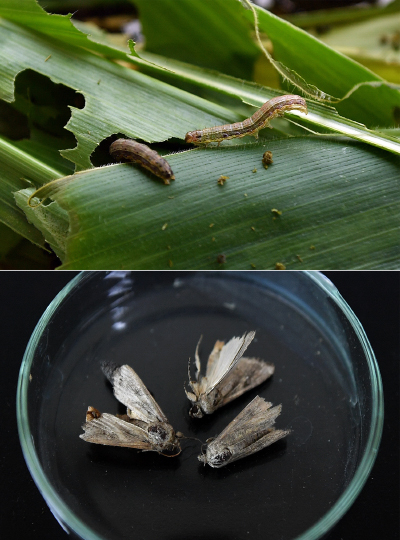| China |
| The barrier against fall armyworm in China wins international recognition | |
|
|
 Qu Dongyu (right), Director General of the Food and Agriculture Organization of the United Nations (FAO), presents the FAO Achievement Award to the Institute of Plant Protection of the Chinese Academy of Agricultural Sciences at a ceremony marking World Food Day in Rome, Italy, on October 16 (XINHUA)
Every March and April, high-altitude searchlights brighten the night sky in fields along the Yangtze River, with beams of light reaching up to 800 meters high. The searchlights, spaced between a few and tens of kilometers apart, are part of a defensive line against invading enemies—pests. Insect-detecting radar systems are also deployed along the Yangtze to monitor the sky around the clock, while food attractants, sex-attractant pheromones and other trapping measures are used on the ground, targeting adult insects. "More than 5,000 searchlight traps are deployed along four lines of defense in China, respectively, along sections of China's border, the Yangtze, the Yellow River and the Great Wall," Zhang Yunhui, a researcher with the Institute of Plant Protection of the Chinese Academy of Agricultural Sciences (IPPCAAS), told newspaper The Beijing News. The installations attract and capture a large number of adult insects. For instance, the three high-altitude searchlights at the field experiment station in Changdao County, Shandong Province, have captured around 3.5 million insects in 20 years, according to Zhang. Among the migratory pests monitored and captured by the defensive lines are moths of the species Spodoptera frugiperda. In their larval stage, caterpillars of this species, known as fall armyworm (FAW), are one of the main threats to corn production in China and internationally. The IPPCAAS was granted the Food and Agriculture Organization of the United Nations (FAO) Achievement Award at a ceremony marking World Food Day in Rome, Italy, on October 16. The IPPCAAS is the first Chinese organization to receive the honor. "Spearheading the development of a sustainable pest management system against the FAW, the institute achieved groundbreaking advancements including accurate forecasting of FAW invasion, establishment of an all-weather monitoring and early-warning network, and implementation of an ecologically friendly regional integrated pest management system," the FAO stated on its website. The organization also said China has shared expertise with Southeast Asian and African nations, and established an international framework for FAW control. An effective battle Pests are a major cause of crop losses and the reduction of yields. The FAO estimates that plant pests and diseases are responsible for reducing global crop yields by 20 to 40 percent each year. The FAW, originating from Central and South America, is an omnivorous migratory pest. It can feed on over 200 types of plants, including more than 80 species of crops, especially grain crops such as corn and wheat. A single moth can lay over 1,000 eggs throughout its lifetime. However, as it is part of the ecological balance in its native habitats, the crop damage it causes there is not particularly significant, according to Xia Jingyuan, Director of the Plant Production and Protection Division of the FAO and special advisor to the FAO director general. In 2016, the FAW was taken unintentionally to West Africa. In the new environment, due to a lack of natural predators and competitors and ineffective prevention and control measures, it has become uncontrollable, resulting in substantial crop losses. Corn growers suffer the highest losses in the region, with up to 50-percent reductions in yield, Xia said. The pest spread throughout Africa in 2017, then to the Near East region in 2018, followed by India, and finally to China. In December 2018, it was first discovered in the southwestern Chinese province of Yunnan. By 2020, the FAW had affected corn producing areas in more than 20 provincial-level regions of China. In 2017, the FAO issued a warning about a possible global FAW outbreak. In 2019, it launched a global prevention and control campaign, designating eight demonstration countries worldwide, with China being one of them. After discovering the invading FAW, Chinese researchers first investigated how it entered China, predicted its migration routes and destinations within the country, and deployed defensive lines to intercept it, Wang Zhenying, an IPPCAAS researcher leading an FAW prevention and control team, told The Beijing News. In October 2018, scientists completed the gene sequencing of the FAW moths that entered China that year, and identified the biological and chemical agents that could effectively control them, according to Wang. Wang said, so far, the spread of the FAW in China has been controlled in areas south of the middle and lower reaches of the Yangtze. Many consider the Yangtze, China's longest waterway, running across its territory from west to east, to be the informal dividing line between the southern and northern parts of the country. Effective prevention and control has reduced the annual occurrence area of the FAW in China by about 5.3 million hectares, preventing an annual loss of corn yield of between 5 million tons and 6 million tons, the IPPCAAS stated in a recent press release. "Strengthening the crop biosecurity management system is of great strategic importance for improving China's food security and promoting high-quality agricultural development," Wu Kongming, a member of the Chinese Academy of Engineering and President of the Chinese Academy of Agricultural Sciences, said at the 74th Xiangshan Science Conferences, held in Beijing on October 11-12. At the event, Lu Yanhui, Director General of the IPPCAAS, said about 140 million tons of grain losses are prevented through disease and pest control in China each year, which is equivalent to about one fifth of the total national yield in 2023. Moreover, he pointed out that environmentally friendly methods have been used to achieve this. "In 2023, the coverage rate of green plant disease and pest prevention and control in China reached 54.1 percent," he said.  The larvae (above) and adults of the fall armyworm in Danzhou, Hainan Province, on March 9, 2020 (XINHUA)
Eco-friendly control As part of ongoing efforts to reduce pesticide use, China is employing eco-friendly measures to combat the FAW. In addition to the light, pheromone and food traps used to lure and kill pests or interfere with their reproduction, biological agents are also being used. These include nuclear polyhedrosis virus and natural enemy insects. Pesticides are used for targeted killing. In response to the invasion of the FAW in China, researchers collected species of its potential natural enemies and evaluated their effectiveness. A widely reported field experiment conducted in Yunnan in 2019 by an IPPCAAS research group revealed that the stink bug is highly capable of detecting FAW moths within its environments, and then uses its proboscis, the sucking organ of an invertebrate, to pierce the body of an FAW moth and inject a paralyzing agent before feeding. Each adult stink bug can feed on up to 41 FAW larvae each day. Other natural enemies of the FAW have also been identified, bred on a large scale and released into fields, including Telenomus remus (Nixon) and Trichogramma chilonis, two parasitoid wasps that attack the eggs of many insect pests. A research team for controlling pests harming economic crops at the Plant Protection Research Institute of the Sichuan Academy of Agricultural Sciences deployed the eggs of Telenomus remus in vegetable, corn, and tobacco fields in Sichuan, Yunnan and Guizhou provinces last year, and in 2,667 hectares of tobacco fields in Sichuan this year. The results showed that over 95 percent of the pests were effectively controlled, and pesticide use was reduced by over 40 percent, yielding considerable economic, ecological and social benefits. Only 15 small balls, each containing 500 wasp eggs, are needed to achieve good control on one hectare of tobacco. Both manual and drone delivery are effective, with drone delivery being more precise than manual delivery. "Only by continuously innovating core technologies for monitoring, early warning, and green prevention and control can we effectively control possible major pests and diseases to ensure food security," IPPCAAS Director General Lu told state broadcaster China Central Television while speaking about China's experience in combating the FAW. Copyedited by G.P. Wilson Comments to wanghairong@cicgamericas.com |
|
||||||||||||||||||||||||||||||
|